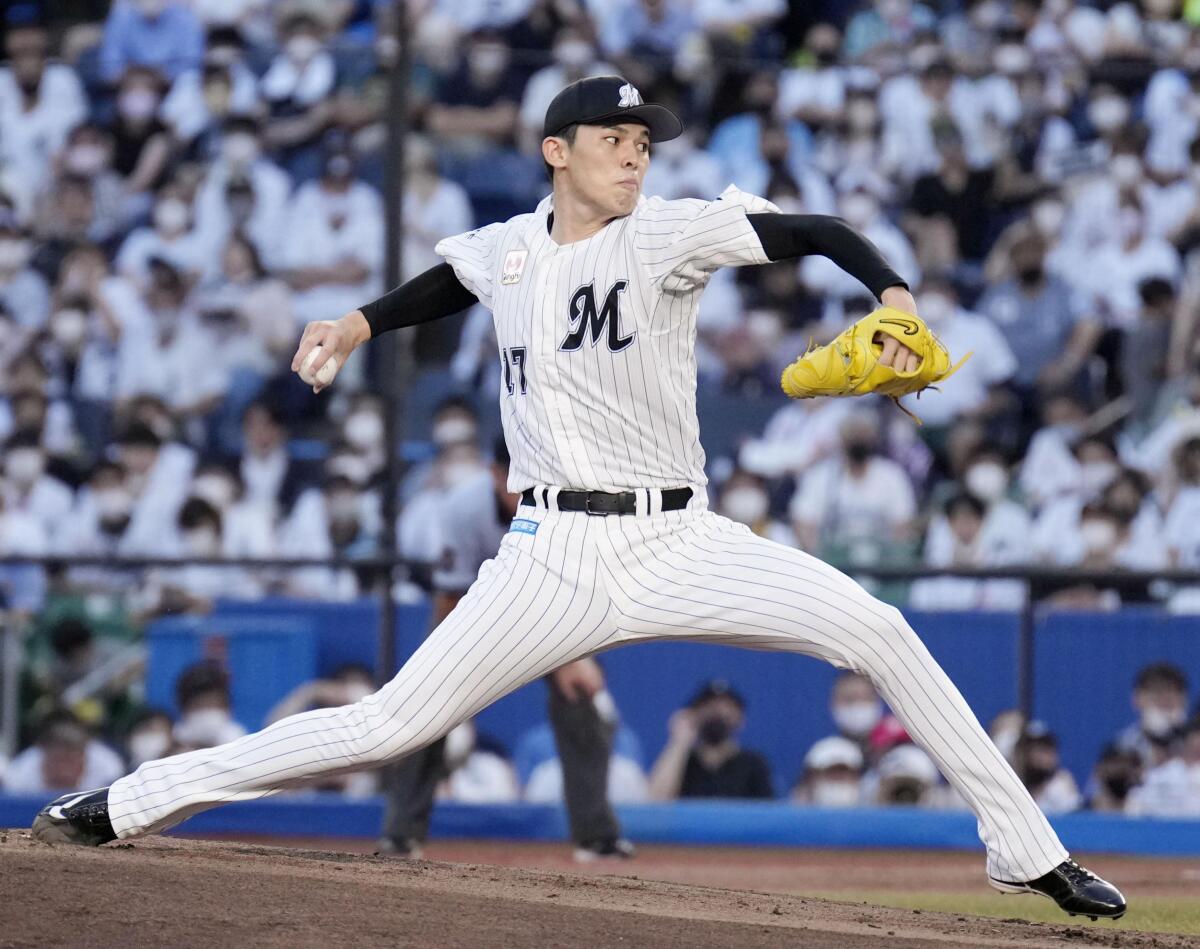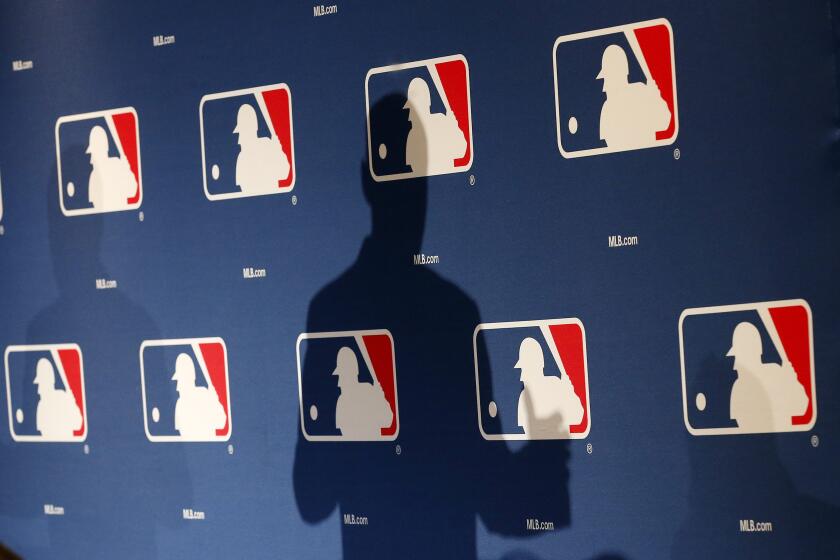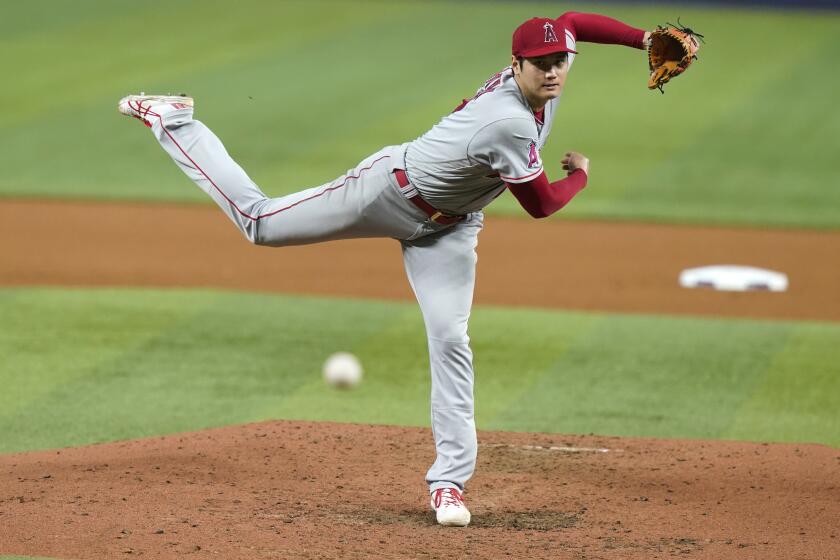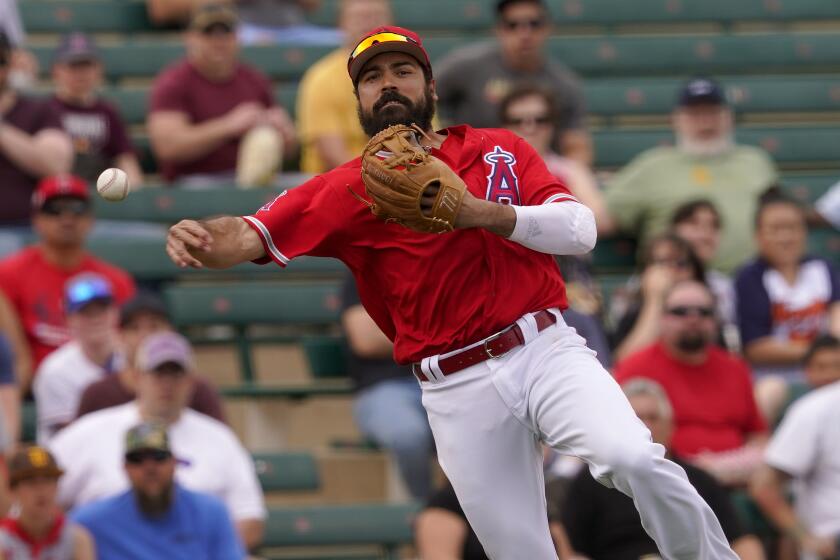Column: Leave Japanese pitching phenom Rōki Sasaki out of proposed MLB international draft

- Share via
He could be the best pitching prospect to ever come from the same Japanese prefecture that produced Shohei Ohtani.
He strikes out an average of 13 batters per nine innings and his fastball approaches 102 mph.
He pitched a perfect game this season and nearly pitched another in his very next start, denied only by his team’s inability to score and his manager’s decision to remove him after eight unblemished innings.
Just 20 years old, Rōki Sasaki could be the best pitcher who won’t be at Dodger Stadium for the All-Star Game on July 19. He’s still in Japan, scheduled to represent the Chiba Lotte Marines a week later in Nippon Professional Baseball’s version of the event.
“I’d like to see him come here as quickly as possible,” San Diego Padres right-hander Yu Darvish said in Japanese.
Darvish isn’t alone.
However, the already modest chances of Sasaki pitching in the major leagues in the next four years could nearly vanish if Major League Baseball succeeds in implementing an international draft.
MLB says an international draft would curb corruption and PED use in Latin America. The union has countered that it won’t solve problems.
Under the MLB’s current proposal, NPB players under age 25 with less than six years of service time would still be classified as amateurs. In addition to limiting their earning power, the designation would subject them to the international draft.
“That would be a bummer,” an executive of a National League team said.
The assumption is that Sasaki or any other NPB player in his position would be less likely to make the financial sacrifices necessary to expedite his move to the major leagues if he couldn’t select his team. Ohtani signed with the Angels for only $2.3 million before the 2018 season but was able to pick his destination.
For what it’s worth, the league is open to negotiating with the players’ union new thresholds that would make players draft-exempt, a person familiar with MLB’s thinking told The Times’ Jorge Castillo. That’s a start.
Major League Baseball is Major League Baseball because it has the world’s best players. That’s its selling point.
You would think the league would want to make it easier for elite players to come here, not harder. You would think that after what Ohtani has accomplished here and overseas, it would do whatever is necessary to open its doors for a player as talented and popular as Sasaki.
Sasaki, whose first name is pronounced Row-key, has been nationally famous in Japan from the time he was in high school.
He is from Iwate, the same rural prefecture that was also the birthplace of Ohtani and Yusei Kikuchi of the Toronto Blue Jays.
Sasaki lost his father and paternal grandparents in the tsunami that ravaged the northern part of Japan’s mainland in 2011. His childhood home was swept away.
In high school, he broke Ohtani’s national high school velocity record by throwing a fastball clocked at 163 km/h, or 101.3 mph. Four teams selected him in the first round of the 2019 NPB draft, with the Marines awarded his rights via a lottery.
Shohei Ohtani gave up one unearned run in seven dominant innings and had the go-ahead hit in the Angels’ 5-2 victory over the Miami Marlins on Wednesday.
Sasaki, who experienced arm trouble in high school, mysteriously didn’t pitch in an NPB or minor league game in his first year as a professional. The Marines said they were focused on building his physique.
Last year, as a 19-year-old, Sasaki was immediately effective. By the time they reached the postseason, he was the Marines’ Game 1 starter.
This year, he’s transformed into the league’s best pitcher, going 6-1 with a 1.48 earned-run average through his first 13 starts. Sasaki struck out an NPB-record 13 consecutive batters during the perfect game against the Orix Buffaloes in his third start. His 19 strikeouts were tied for the most in league history.
In his next start, he pitched eight more perfect innings against the Nippon-Ham Fighters. With the score tied 0-0, Sasaki was removed from the game by his manager, former major leaguer Tadahito Iguchi.
The early-season performances prompted one high-ranking major league official to compare Sasaki’s fastball to Jacob deGrom’s and declare that Sasaki was already one of the five best pitchers in the world.
One major league talent evaluator who recently watched Sasaki was more reserved in his praise.
“My concern with him is that it’s predominantly fastball-split right now,” said the evaluator, who spoke on the condition of anonymity because his team prohibits him from sharing his observations. “I don’t know if he’s ready right now. He dominates over there because he’s overpowering with the fastball. It’s [comparable to] Kevin Gausman.”
Gausman was an All-Star last year.
The greater concern is over how he will eventually reach the major leagues. While highly rated Kodai Senga is expected to move to the United States this winter with Yoshinobu Yamamoto believed to be following him a year later, major league teams already have their eyes set on Sasaki.
The current system doesn’t offer the Marines much of an incentive to post Sasaki before he turns 25. His amateur classification means he can sign only a minor league contract, with his bonus coming from his signing team’s international bonus pool. The Marines would be paid 20% of that amount as a release fee, so if Sasaki signed for $2.3 million the way Ohtani did, they would collect only $460,000.
It’s clear the Angels haven’t gotten their money’s worth in oft-injured Anthony Rendon, and that could complicate their hopes of re-signing Shohei Ohtani.
Some industry insiders were hopeful the creation of an international draft and consequent elimination of the international bonus pool could prompt MLB to make changes to its posting agreement with NPB, thereby opening the door for Sasaki to come to the United States in the next few years. But if anything, the opposite could happen, with a cracked-open door about to be closed entirely.
MLB defends the restrictions on young players as mechanisms to ensure the long-term health of NPB, as well as a respectful relationship between the two leagues. There’s something to that. However, attitudes have shifted in Japan, where fears of a talent drain are now overwhelmed by a desire to watch to country’s best challenge themselves on the most difficult of stages, evidenced by how Japan’s major sports newspapers are already speculating about how much Sasaki could be worth to MLB teams.
Furthermore, NPB has proved to be indestructible in recent years, with baseball’s popularity in Japan making the league immune to the most painful of departures, from Ichiro Suzuki’s to Ohtani’s.
In reality, this is about cost control. MLB wanted to limit the fees its teams pay its NPB counterparts after the Texas Rangers cut the Fighters a $51.7-million check for Darvish’s rights. To compensate NPB teams for the artificial suppression of transfer fees, MLB has made it nearly impossible for its teams to raid Japan of its most promising young talent.
MLB should be mindful of what its brand represents, a global platform for the best of the best. Sasaki might not yet be that, but he could be soon. When he does, he should be pitching here, regardless of the price. Regulations must be changed to make that happen.
More to Read
Go beyond the scoreboard
Get the latest on L.A.'s teams in the daily Sports Report newsletter.
You may occasionally receive promotional content from the Los Angeles Times.














